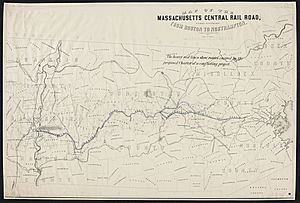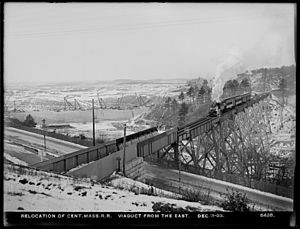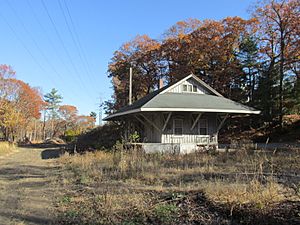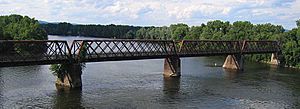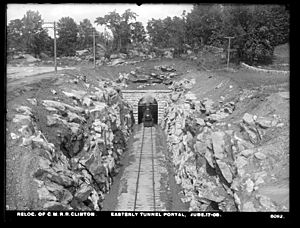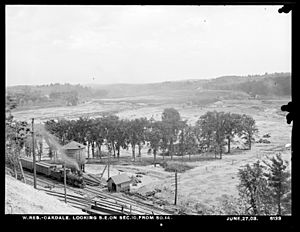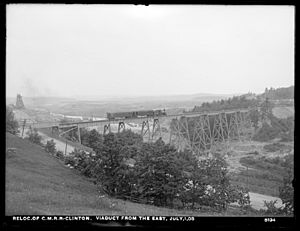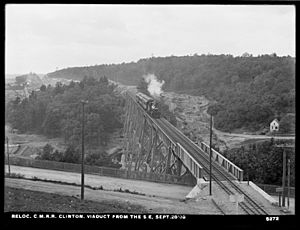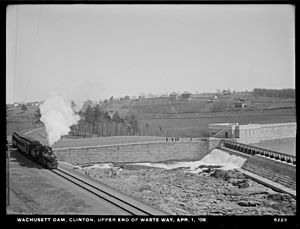Central Massachusetts Railroad facts for kids
The Central Massachusetts Railroad was a railway line in Massachusetts. It connected many towns across the state. The line started in North Cambridge and ran for almost 99 miles west. It went through towns like Belmont, Waltham, Hudson, Clinton, Ware, and Amherst. The railroad ended in Northampton. From North Cambridge, trains could reach North Station in Boston.
Contents
History of the Central Massachusetts Railroad
Building the Railroad (1868–1883)
In the late 1860s, people in towns like Sudbury, Wayland, and Weston asked the state government to build a railroad. On February 21, 1868, the state officially allowed the Wayland and Sudbury Branch Railroad to be built. It was a short line, about 6.75 miles long.
Later that year, more people asked for the railroad to go all the way to Northampton. So, on May 10, 1869, the state allowed the Massachusetts Central Railroad to be created. It joined with the Wayland and Sudbury Branch.
Construction started in the fall of 1869. But it was hard to get enough money. A company called Norman Munson started building the railroad in April 1871. However, a big money problem in 1873 (called the Panic of 1873) made Munson's company go broke. This stopped the building work.
The railroad project paused until 1878. Then, new leaders took over. They hired Munson again to finish the job. In 1879, the state allowed the railroad to expand. The most important change was extending the line east to Waltham and Belmont. This new path connected the railroad to the Boston and Lowell Railroad (B&L) in North Cambridge.
The B&L agreed to operate the Massachusetts Central Railroad for 25 years once it was finished. The first tracks were laid in October 1880. The line from Cambridge to Hudson was ready by August 1881. The railroad officially opened on October 1, 1881. It had five locomotives and offered passenger trips from Boston to Hudson. It also had daily freight service.
Building continued west, reaching Oakdale and Jefferson by June 1882. But in 1883, the companies that sold the railroad's bonds (like loans) went bankrupt. The railroad stopped all operations and construction on May 16, 1883.
New Beginnings with Boston & Maine (1883–1902)
To get trains running again, a new company called the Central Massachusetts Railroad was formed on November 10, 1883. They made a deal with the B&L to run trains on their tracks. Service started again from Boston to Hudson on September 28, 1885. By December 14, trains were running to Jefferson.
The B&L officially leased the Central Massachusetts on December 7, 1886. They continued building the line towards Northampton. They changed the route to go through the Ware River Valley, which was easier terrain. This was a good choice because parts of the old planned route were later flooded to create the Quabbin Reservoir. Tracks reached Muschopauge by November.
On April 1, 1887, the Boston and Maine Railroad (B&M) leased the B&L. The Central Massachusetts line was then called the Central Massachusetts Branch. Tracks reached Ware on June 27, 1887. By the end of that year, the bridge over the Connecticut River was finished. The first train to travel the whole route left Boston on December 12, arriving in Northampton four hours later. Regular service started on December 19, with daily passenger trips.
Even though the Central Massachusetts Railroad didn't expand past Northampton, it became a very important link for the B&M. It connected New England to cities south of New York City. This was especially true after the Poughkeepsie Bridge was built in 1889. This bridge created the first all-rail route between New England and places like Philadelphia and Washington, D. C.. Trains like the Philadelphia and Washington Express used the Central Massachusetts Branch.
In 1892, a railroad president named Archibald Angus McLeod tried to control the B&M. He wanted to use the line to move coal from Pennsylvania to New England. But his company went bankrupt in 1893, and he lost control of the B&M. The B&M then leased another major railroad, the Fitchburg Railroad, in 1900. Two years later, on February 20, 1902, the B&M bought the Central Massachusetts Railroad completely.
After buying the line, the B&M made improvements. They closed a dangerous crossing in Oakdale in 1902. They also improved connections at Jefferson and Gleasondale to allow passenger service to other towns like Marlborough.
Wachusett Reservoir Changes (1902–1907)
In 1895, the state decided to build the Wachusett Reservoir. This meant flooding about 4,000 acres of land in Clinton, Boylston, and West Boylston. The Central Massachusetts Branch had to be moved because 7.01 miles of track and several stations would be underwater.
The B&M agreed to build a new route through Clinton. This new part of the line started in Berlin. It went northwest into Clinton through a 1,110-foot-long tunnel. The tunnel opened onto a 917-foot viaduct (a long bridge) that crossed over Route 70 and the Nashua River. This new route connected with another main line. The first train used the new route on June 2, 1903. The old tracks were removed from service on June 15, 1903.
Operation under Charles Mellen (1907–1913)
In 1907, Charles Sanger Mellen, who led another big railroad company, took control of the B&M. He wanted to create a direct route through Springfield to send more train traffic to Boston using the Central Massachusetts Branch. He planned to lease a new railroad line called the Hampden Railroad.
The Hampden Railroad was officially created in July 1910. It started near Bondsville on the Central Massachusetts Branch and went southwest for almost 15 miles to Springfield. Construction finished by May 9, 1913. Trains were supposed to start running on June 23. However, Mellen faced legal problems and resigned on July 9. This left the Hampden Railroad unused, and it was finally shut down in 1925.
Changes and Closures (1913–1939)
The failure of the Hampden Railroad marked the start of problems for the Central Massachusetts Branch. Much of its train traffic disappeared. In August 1917, the B&M stopped passenger service between Ware and Northampton. The line saw a small increase in traffic after World War I, but the Great Depression and more cars and trucks caused problems. By 1928, only one passenger train ran the whole length of the line each day.
To save money, the B&M started cutting back on less profitable lines. In 1931, they made a deal to use the tracks of another railroad, the Central Vermont Railway, between Belchertown and Amherst. This allowed the B&M to stop using its own parallel tracks in that area. In 1933, they did something similar with the Ware River Branch of the B&A. They used the Ware River Branch for trains and turned parts of the Central Massachusetts Branch into short side tracks.
The B&M also reduced service. Passenger service to Northampton ended on April 23, 1932. By 1938, most of the traffic on the Central Massachusetts Branch was east of Clinton. The western part of the line only had local freight service. Because trains weren't using the middle section, the B&M stopped using the tracks between Oakdale and Muschopauge on June 1, 1938.
Later that year, the Hurricane of 1938 badly damaged the tracks. The B&M couldn't afford to fix them. So, on January 30, 1939, they asked to officially abandon (close) parts of the tracks. This split the line into two main parts. The section between Northampton and Wheelwright was renamed the Wheelwright Branch. The eastern part, from Boston to Oakdale, kept the name Central Massachusetts Branch.
End of the Wheelwright Branch
Freight service continued on the Wheelwright Branch until 1973, when a paper mill in Wheelwright closed. In 1974, the B&M stopped using the tracks between Creamery and Wheelwright. In 1979, the railroad asked to abandon the rest of the Wheelwright Branch. They said a new railroad, the Massachusetts Central Railroad, could serve the remaining customers. The last trains ran on the Wheelwright Branch in November 1979.
In 1980, the B&M officially stopped using the line from Northampton to Norwottuck. The Massachusetts Central Railroad tried to serve the customer in Bondsville, but the tracks were in bad shape. In 1982, the B&M removed the tracks between Northampton and Norwottuck. By 1983, the last remaining parts of the Wheelwright Branch were also removed. As of 2006, only a small section of the original Central Massachusetts Railroad in Ware is still used by the Massachusetts Central Railroad for a paper plant.
Decline in the East (1939–2006)
In 1939, passenger service to Marlborough ended. The last passenger trains on the Central Massachusetts Branch were four daily trips between Boston and Clinton. However, freight service increased during World War II. The U.S. Government built the Fort Devens-Sudbury Training Annex in 1942, which connected to the Central Massachusetts Branch. B&M trains carried large amounts of ammunition to and from this facility. This business ended after the war.
In the early 1950s, the B&M modernized its rail system around Boston. They decided to connect the Central Massachusetts Branch with the Fitchburg Division at Clematis Brook. This meant they could remove the Central Massachusetts Branch tracks between Clematis Brook and Hill Crossing. The remaining track became part of a freight shortcut. Around the same time, the B&M started using diesel locomotives instead of steam locomotives. The last steam-powered passenger train on the Central Massachusetts Branch ran on May 5, 1956. After that, the railroad used special self-propelled railcars for passenger service.
By 1958, train business between Clinton and Boston had almost disappeared. The B&M stopped all service west of Berlin. On August 11, the tracks between Berlin and Clinton Junction were removed. The big viaduct in Clinton was taken down in 1974. On June 14, 1959, the B&M further reduced passenger service to just one daily trip to Hudson.
MBTA Takes Over and Closes Lines
Quick facts for kids Central Mass Branch |
|
|---|---|
| Overview | |
| Status | Abandoned |
| Owner | Boston and Maine Railroad |
| Locale | East-Central Massachusetts |
| Termini | Hudson, Massachusetts North Station, Boston, Massachusetts |
| Stations | 14 |
| Service | |
| Type | Commuter Rail |
| System | MBTA Commuter Rail |
| Rolling stock | Budd RDCs |
| History | |
| Opened | 1964 |
| Closed | November 26, 1971 |
| Technical | |
| Line length | 28 miles |
| Character | Surface |
| Track gauge | Standard (1,435 mm (4 ft 8 1⁄2 in)) |
In 1964, the state created the Massachusetts Bay Transportation Authority (MBTA) to help fund and manage commuter train service. The MBTA started by cutting passenger service on the Central Massachusetts Branch back to South Sudbury on January 18, 1965.
Even with state help, fewer people rode the trains. By 1969, the MBTA suggested ending all service on the line. In December 1970, the B&M went bankrupt. On November 26, 1971, all passenger service on the Central Massachusetts Branch officially ended. The MBTA looked into bringing back passenger service in 1972 and 1975, but it didn't happen.
Despite the end of passenger service, freight trains continued to run to South Sudbury and sometimes to Hudson. In 1974, the B&M removed the last section of the Marlborough Branch. On December 27, 1976, the B&M sold the Central Massachusetts Branch to the MBTA, but kept the right to run freight trains. However, freight business kept going down. By 1977, the tracks between Berlin and Hudson were too old to use safely and were removed. In August 1979, the B&M asked to abandon the Central Massachusetts Branch between Berlin and Waltham North Station. The last train to Hudson ran on June 19, 1980. The tracks west of Bacon Street in Waltham were officially taken out of service on September 11.
In 1983, a company called Guilford Rail System bought the B&M. They transferred all operations to another company, Springfield Terminal Railway. Springfield Terminal continued freight operations on the last part of the Central Massachusetts Branch in Waltham until the last customer closed in 1994.
In 1996, some people suggested bringing back commuter train service on the Central Massachusetts Branch. This would help with traffic on Route 20. However, many people who had built new homes along the old train line were against it. A study found that restoring service would be very expensive and might not be worth the cost. In 1999, another idea was to turn the old railroad path into a special bus lane, but this was also rejected. As of 2006, many of the old crossings and bridges have been removed, but parts of the tracks are still there, though overgrown.
Rail Trail Plans
In 1996, towns along the eastern part of the Central Massachusetts Branch asked to turn the old route into a walking and biking path called the Wayside Rail Trail. The MBTA agreed to let them use the land, but said they could take it back for a train line if needed. Most towns agreed, but Weston did not at first. Waltham went ahead and started building the trail in their city anyway. As of Spring 2021, Weston and Wayland have opened a 5-mile paved section of the trail.
Other parts of the old railroad have also become trails. The Marlborough Branch became the Assabet River Rail Trail. In Boston, a section of the old Central Massachusetts Branch became the Fitchburg Cutoff Path.
Towns along the former Wheelwright Branch also wanted to create trails. In 1985, the state bought 10 miles of the line between Northampton and Amherst to turn it into a trail. Work started in 1992, and on July 29, 1993, the Norwottuck Branch Rail Trail officially opened. By 1997, the trail reached Belchertown. In 2006, the western end of the trail was extended. In West Boylston, Holden, and Rutland, volunteers started turning about 30 miles of the old property into the Mass Central Rail Trail.
Locomotives
The Massachusetts Central Railroad owned five locomotives between 1881 and 1883. After that, other railroads provided the trains.
- No. 1
- Model: 4-4-0 (a type of steam locomotive)
- Manufacturer: Rogers Locomotive and Machine Works
- Date Built: 1873
- History: This locomotive was first used by another railroad. The Massachusetts Central Railroad bought it in 1881. It was later sold to other railroads and was scrapped (taken apart) in 1892.
- No. 2
- Model: 4-4-0
- Manufacturer: Rogers Locomotive and Machine Works
- Date Built: July 26, 1873
- History: Like No. 1, this locomotive was also first used by another railroad. The Massachusetts Central Railroad bought it in 1881. It later became part of the B&L and then the B&M. It was scrapped in 1907.
- No. 3
- Model: 4-4-0
- Manufacturer: Schenectady Locomotive Works
- Date Built: October 1881
- History: This locomotive was built specifically for the Massachusetts Central Railroad. It later became part of the B&L and then the B&M. It was rebuilt in 1898 and scrapped in 1920.
- No. 4
- Model: 4-4-0
- Manufacturer: Schenectady Locomotive Works
- Date Built: October 1881
- History: This locomotive was also built for the Massachusetts Central Railroad. It later joined the B&L and B&M. It was rebuilt in 1904 and scrapped before 1923.
- No. 5
- Model: 4-4-0
- Manufacturer: Hinkley & Williams
- Date Built: October 1867
- History: This locomotive was used by a construction company before the Massachusetts Central Railroad bought it around 1882. It was sold at an auction in 1886.
Other Trains Used
Sometimes, the Massachusetts Central Railroad leased trains from the B&L. Smaller 4-4-0, 4-6-0, and 0-4-0 locomotives were common until 1900. This was partly because of weight limits on the bridges. After 1900, 4-4-0 locomotives mostly handled passenger service. Larger locomotives like 2-6-0s and 4-8-0s were used for longer trips and freight. During World War II, 2-8-0 locomotives pulled large ammunition trains.
Diesel trains arrived in the mid-1950s. Special diesel engines with steam generators took over passenger service in 1956. Soon after, self-propelled railcars (like small trains that run on their own) replaced the diesel engines for passenger service. These railcars continued until passenger service ended in 1971.
Stations and Junctions
The Central Massachusetts Railroad built its stations in a style popular in the 1870s, similar to Gothic and Victorian designs. The stations were made of wood and based on two main plans: one for smaller towns and one for larger towns. They often had extra buildings like freight houses or milk sheds. The railroad tried to make each station look a little different, except for Waverly and Belmont, where the similar design helped passengers tell them apart from other railroad stations.
The list of stations changed many times over the years. The table below shows the stations from a 1920 timetable. Stations with gray backgrounds were abandoned when the Wachusett Reservoir was built.
| City | Milepost | Station/ Junction | Date Opened | Date Agency Closed | Date Closed | Train Order Office | Telegraph Symbol | Notes |
|---|---|---|---|---|---|---|---|---|
| Boston | 0.00 | North Union Station | 1893 | 1927 | Continuous | HO | Before this, it was the Boston and Lowell Railroad (B&L) terminal. Later replaced by North Station. | |
| Cambridge | 4.39 | North Cambridge | October 1, 1881 | April 23, 1927 | April 24, 1927 | Continuous | AU | Connected to the Lexington Branch at North Cambridge Junction. |
| Belmont | 5.80 | Hill Crossing | Before December 19, 1887 | Before August 1964 | N/A | N/A | Starts running next to the Fitchburg Division. | |
| 6.70 | Belmont | October 1, 1881 | 1952 | N/A | N/A | Runs next to the Fitchburg Division. | ||
| 7.68 | Waverley | October 1, 1881 | 1918 | 1952 | Day | WY | Runs next to the Fitchburg Division. | |
| 8.58 | Clematis Brook | Before December 19, 1887 | Before August 1964 | N/A | N/A | Connects with the Fitchburg Division. Stops running next to the Fitchburg Division. | ||
| Waltham | 10.05 | Waltham North | October 1, 1881 | November 26, 1971 | N | WA | Called Waltham before April 1912. | |
| 10.64 | Waltham Highlands | October 1, 1881 | November 26, 1971 | N/A | N/A | The station building is still standing as of 2017. | ||
| Weston | 13.24 | Weston | October 1, 1881 | November 26, 1971 | Day | WS | The station building is still standing and privately owned. | |
| 13.97 | Cherry Brook | Before October 9, 1882 | 1913 | November 26, 1971 | N/A | N/A | The passenger shelter was taken down in 1996. | |
| Wayland | 15.53 | Tower Hill | October 1, 1881 | December 31, 1920 | November 26, 1971 | N/A | N/A | The original station burned down around 1890. |
| 16.77 | Wayland | October 1, 1881 | November 29, 1949 | November 26, 1971 | Day | ND | The station and freight house are still standing and owned by the Town of Wayland. | |
| Sudbury | 18.84 | East Sudbury | Before December 19, 1887 | 1913 | November 26, 1971 | N/A | N/A | Ticket sales stopped in 1888. |
| 19.99 | South Sudbury | October 1, 1881 | November 26, 1971 | Continuous | BU | Connects with the Framingham-Lowell Branch. The new station built in 1952 is still used by a local business. | ||
| 21.93 | Wayside Inn | October 1, 1881 | None | Before 1944 | N/A | N/A | A flag stop (trains only stopped if someone waved a flag). Burned down in the 1940s. | |
| Hudson | 23.34 | Mirror Lake Junction | 1942 | None | 1945 | N/A | N/A | No station. Connected to the Fort Devens-Sudbury Training Annex. |
| 24.14 | Ordway | 1902 | January 17, 1965 | N/A | N/A | The passenger shelter was taken down in 1972. | ||
| 25.64 | Gleasondale | October 1, 1881 | December 1, 1924 | January 17, 1965 | N/A | N/A | Called Rockbottom before 1900. | |
| 26.28 | Gleason Junction | 1902 | January 17, 1965 | Day | N/A | No station. Connected with the Marlborough Branch. | ||
| Marlborough Branch | ||||||||
| Hudson | Hudson | 1850 | January 17, 1965 | N/A | N/A | The B&M took over operations from the Central Massachusetts Branch in 1902. | ||
| Marlborough | Marlborough | 1855 | 1939 | N/A | N/A | The B&M took over operations from the Central Massachusetts Branch in 1902. | ||
| Hudson | 28.00 | Hudson | October 1, 1881 | December 30, 1950 | Day | HD | The station building is still standing but looks very different. | |
| Bolton | 29.78 | South Bolton | Before October 9, 1882 | January 10, 1921 | Before 1944 | N/A | N/A | Formerly called Bolton. |
| Berlin | 31.71 | Berlin | Before December 29, 1881 | January 30, 1931 | Day | BE | ||
| 32.78 | West Berlin Junction | Before October 9, 1882 | None | August 11, 1958 | N/A | N/A | No station. Connected with the Fitchburg Line. | |
| Old Route Before 1903 Wachusett Reservoir Changes | ||||||||
| Clinton | 35.60 | South Clinton | Before December 29, 1881 | June 1903 | N/A | N/A | Closed because of the Wachusett Reservoir construction. | |
| Boylston | 36.85 | Boylston | Before December 29, 1881 | June 1903 | N/A | N/A | Closed because of the Wachusett Reservoir construction. | |
| West Boylston | 39.96 | West Boylston | Before December 29, 1881 | June 1903 | Day | CN | Closed because of the Wachusett Reservoir construction. | |
| 41.30 | Oakdale | Before December 29, 1881 | June 1903 | Day | OD | The station stayed, but the tracks around it were changed. | ||
| Clinton | 35.62 | Reservoir Switch | 1903 | None | August 11, 1958 | Day | N/A | No station. Formed a wye (Y-shaped track) to another main line. |
| 36.38 | East Switch | 1903 | None | August 11, 1958 | Day | N/A | No station. Connection at the north end of another main line. | |
| 36.80 | Clinton Junction | 1903 | August 11, 1958 | Continuous | N/A | Connection at the south end of another main line. | ||
| Sterling | Sterling Junction | Day | SJ | Station on another main line. | ||||
| West Boylston | 41.56 | Oakdale | 1903 | June 30, 1932 | Continuous | OD | Split off from another main line. | |
| Holden | 43.00 | Springdale | 1882 | Before 1892 | N/A | N/A | ||
| 44.79 | Canada Mills Siding | 1882 | None | Before June 1, 1938 | N/A | N/A | No station. A passing siding (extra track for trains to pass each other). | |
| 46.09 | Quinapoxet | Before December 29, 1881 | October 1925 | November 13, 1928 | N/A | N/A | Called Holden before the 1880s. | |
| 47.00 | Holden Junction | Before December 29, 1881 | None | 1909 | N/A | N/A | No station. Connected with the Worcester & Hillsboro Branch. | |
| 48.38 | Jefferson | June 1882 | Before June 1, 1938 | Day | JF | Called Jefferson's before 1898. | ||
| Rutland | 51.66 | Muschopauge | 1898 | June 25, 1925 | N/A | N/A | ||
| 53.05 | Summit Siding | Before December 19, 1887 | None | January 30, 1939 | N/A | N/A | No station. Highest point on the Central Massachusetts Branch (1,061 feet). | |
| 54.29 | Rutland | Before December 19, 1887 | September 6, 1934 | January 30, 1939 | Continuous | RU | ||
| 56.29 | West Rutland | Before December 19, 1887 | August 11, 1927 | January 30, 1939 | Day | RD | ||
| Oakham | 59.96 | Coldbrook | Before December 19, 1887 | August 12, 1926 | Day | CB | ||
| Barre | 61.68 | Barre | Before December 19, 1887 | July 27, 1928 | January 30, 1939 | Day | RE | |
| Barre Junction | 1933 | None | January 30, 1939 | N/A | N/A | No station. Connected with the Ware River Branch. | ||
| 63.46 | Barre Plains | Before December 19, 1887 | January 31, 1940 | 1933 | Day | BS | ||
| Hardwick | 65.85 | Wheelwright | Before December 19, 1887 | April 11, 1935 | April 1974 | Day | RW | Called Hardwick before 1894. |
| New Braintree | 66.77 | New Braintree | Before December 19, 1887 | 1918 | Before April 1974 | Day | Z | |
| Hardwick | Creamery | 1933 | None | April 1974 | N/A | N/A | No station. Connected with the Ware River Branch. | |
| 70.57 | Gilbertville | Before December 19, 1887 | Assumed by B&A October 1, 1939 | 1938 | Day | GR | The station building is still standing and has a pizza shop. | |
| Ware | 74.91 | Ware | June 27, 1887 | Joint with B&A | 1975 | Continuous | AR | Ware Union Station was shared with the B&A. |
| Forest Lake Junction | 1932 | None | 1975 | N/A | N/A | No station. Connected with the Ware River Branch. | ||
| Palmer | Hampden Junction | 1913 | None | 1913 | N/A | N/A | No station. Connected with the Hampden Railroad. | |
| 79.14 | Gates Siding | 1887 | None | 1975 | N/A | N/A | No station. | |
| 82.58 | Bondsville | Before December 19, 1887 | Also served Wheelwright beginning in 1960s, closed September 28, 1973 | August 1979 | Day | BV | The station was taken down in 1980 during a fire department training. | |
| Belchertown | 87.18 | Canal Junction | 1931 | None | August 1979 | N/A | N/A | No station. Connected with the Southern Division. |
| 87.90 | Belchertown | Before December 19, 1887 | Joint with CV | 1931 | Day | BN | ||
| 92.47 | Pansy Park | Before 1890 | 1913 | 1931 | N/A | N/A | ||
| Amherst | 94.80 | Norwottuck | Before December 19, 1887 | May 26, 1924 | Day | RS | Called South Amherst before 1910. | |
| 97.29 | Amherst | Before December 19, 1887 | April 24, 1938 | November 1979 | Day | MH | The station and freight sheds are now used by Amherst Farmer's Supply. | |
| Hadley | 99.41 | East Hadley | 1896 | April 23, 1932 | N/A | N/A | ||
| 101.60 | Hadley | Before December 19, 1887 | March 25, 1955 | Day | HY | The freight house is still standing. The water tower is now used for municipal water. | ||
| Northampton | 103.64 | N. O. Tower | Before December 19, 1887 | None | November 1950 | Continuous | NO | Connected with the Connecticut River Division main line. |
| 104.67 | Northampton | 1897 | Day | NA/ NR | Located on the Connecticut River Division main line. The station building is still standing and has restaurants. | |||


